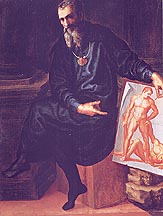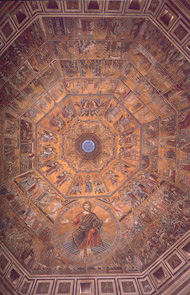Art Home | ARTH Courses | ARTH 294 Syllabus
Introduction
The comparison above is intended to introduce some of the major transformations we will witness in the conception of the artist in the Renaissance. The image on the left is a relief that decorates the base of the monument commissioned by the Arte dei Maestri di Pietra e Legname or the guild of the masters of stone and wood carvers in Florence. The major Florentine guilds were given the responsibility of decorating niches assigned to them on the exterior of Orsanmichele. ![]() This monument attests to the important role guilds played in the social and political world of Florence. Nanni di Banco's niche is most known for his figure group of the so-called Quattro Santi Coronati or Four Crowned Martyrs. Clearly emulating Roman statuary, Nanni di Banco represents four Christian sculptors who were martyted for refusing the request of the Emperor Diocletian to carve a statue of the god Aesculapius. For our purposes, the predella below is interesting in that it illustrates members of the guild at work. What does this say about the nature of the artist / craftsman at the beginning of the fifteenth century?
This monument attests to the important role guilds played in the social and political world of Florence. Nanni di Banco's niche is most known for his figure group of the so-called Quattro Santi Coronati or Four Crowned Martyrs. Clearly emulating Roman statuary, Nanni di Banco represents four Christian sculptors who were martyted for refusing the request of the Emperor Diocletian to carve a statue of the god Aesculapius. For our purposes, the predella below is interesting in that it illustrates members of the guild at work. What does this say about the nature of the artist / craftsman at the beginning of the fifteenth century?
Constrast to the image on the right which is a self-portrait of a sixteenth-century Florentine sculptor, Baccio Bandinelli. A younger contemporary of Michelangelo and a rival of other Florentine sculptors of the period, most notably Benevenuto Cellini, Bandinelli presents in this self-portrait a statement of his position as an artist. You are encouraged to review the web page I have dedicated to this painting.
The shift we see between these two works can also be seen in relationship to the profound change in the conception of the individual to society marked by this period. This shift can be documented by a comparison of two texts. The first text is the introduction of Cennino Cennini's Il libro dell'arte (or Craftsman's Handbook), a very valuable text written about 1400 (A translation of the complete text is available on the web):
| Here begins the craftsman's handbook, made and composed by Cennino Cennini of Colle, in the reverence of God, and of the Virgin Mary, and of Saint Eustace, and of Saint Francis, and of Saint John the Baptist, and of Saint Anthony of Padua, and, in general of all the Saints of God; and in the reverence of Giotto, of Taddeo, and of Agnolo, Cennino's master; and for the use and good profit of anyone who wants to enter this profession.
The First Chapter of the First Section of This Book It is not without the impulse of a lofty spirit that some are moved to enter this profession, attractive to them through natural enthusiasm. Their intellect will take delight in drawing, provided their nature attracts them to it of themselves, without any master's guidance, out of loftiness of spirit. And then, through this delight, they come to want to find a master; and they bind themselves to him with respect for authority, undergoing an apprenticeship in order to achieve perfection in all this. There are those who pursue it, because of poverty and domestic need, for profit and enthusiasm for the profession too; but above all these are to be extolled the ones who enter the profession through a sense of enthusiasm and exaltation. You, therefore, who with lofty spirit are fired with this ambition, and are about to enter the profession, begin by decking yourselves with this attire: Enthusiasm, Reverence, Obedience, and Constancy. And begin to submit yourself to the direction of a master of instruction as early as you can; and do not leave the master until you have to.
|
Compare especially the introduction of this text to the late thirteenth century mosaic that decorated the ceiling of the Florentine Baptistry:
Last Judgment on the ceiling of the Baptistry in Florence. Attributed to Coppo di Marcovaldo and dated to the second half of the 13th century. Scenes from the Old and New Testament also appear including Creation scenes from Genesis and scenes from the life of Christ and John the Baptist. All Florentines up until relatively recent years would have been Baptised under this mosaic dome. Through Baptism they would become members of the church and become Florentines. |
Contrast the conception of the relationship of the individual to society with the following excerpts from the famous Oration on the Dignity of Man by the Florentine humanist Pico della Mirandola presented in 1486:
| I have read in the records of the Arabians, reverend Fathers, that Abadala the Saracen, when questioned as to what on this stage of the world, as it were, could be seen most worthy of wonder, replied: "There is nothing to be seen more wonderful than man." In agreement with this opinion is the saying of Hermes Trismegistus: "A great miracle, Asclepius, is man." But when I weighed the reason for these maxims, the many grounds for the excellence of human nature reported by many men failed to satisfy me --that man is the intermediary between creatures, the intimate of the gods, the king of the lower beings, by the acuteness of his senses, by the discernment of his reason, and by the light of his intelligence the interpreter of nature, the interval between fixed eternity and fleeting time, and (as the Persian say) the bond, nay, rather, the marriage song of the world, on David's testimony but little lower than the angels. Admittedly great though these reasons be, they are not the principal grounds, that is, those which may rightfully claim for themselves the privilege of the highest admiration. For why should we not admire more the angels themselves and the blessed choirs of heaven? At last it seems to me I have come to understand why man is the most fortunate of creatures and consequently worthy of all admiration and what precisely is that rank which is his lot in the universal chain of Being --a rank to be envied not only by brutes but even by the stars and by minds beyond this world. It is a matter past faith and a wondrous one. Why should it not be? For it is on this very account that man is rightly called and judged a great miracle and a wonderful creature indeed.
But hear, Fathers, exactly what this rank is and, as friendly auditors, conformably to your kindness, do me this favor. God the Father, the supreme Architect, had already built this cosmic home we behold, the most sacred temple of His godhead, by the laws of His mysterious wisdom. The region above the heavens He had adorned with Intelligences, the heavenly spheres He had quickened with eternal souls, and the excrementary and filthy parts of the lower world He had filled with a multitude of animals of every kind. But, when the work was finished, the Craftsman kept wishing that there were someone to ponder the plan of so great a work, to love its beauty, and to wonder at its vastness. Therefore, when everything was done (as Moses and Timaeus bear witness), He finally took thought concerning the creation of man. But there was not among His archetypes that form which He could fashion a new offspring, nor was there in His treasure-houses anything which He might bestow on His new son as an inheritance, nor was there in the seats of all the world a place where the latter might sit to contemplate the universe. All was now complete; all things had been assigned to the highest, the middle, and the lowest orders. But in its final creation it was not the part of the Father's power to fail as though exhausted. It was not part of His wisdom to waver in a needful matter through poverty of counsel. It was not the part His kindly love that he who was to praise God's divine generosity in regard to others should be compelled to condemn it in regard to himself. At last the best of artisans ordained that creature to whom He had been able to give nothing proper to himself should have joint possession of whatever had been peculiar to each of the different kinds of being. He therefore took man as a creature of indeterminate nature and, assigning him a place in the middle of the world, addressed him thus: "Neither a fixed abode nor a form that is thine alone nor any function peculiar to thyself have we given thee, Adam, to the end that according to thy longing and according to thy judgment thou mayest have and possess what abode, what form, and what functions thou thyself shalt desire. The nature of all other beings is limited and constrained within the bounds of laws prescribed by Us. Thou, constrained by no limits, in accordance with thine own free will, in whose hand We have placed thee, shalt ordain for thyself the limits of thy nature. We have set thee at the world's center that thou mayest from thence more easily observe whatever is in the world. We have made thee neither of heaven nor of earth, neither mortal nor immortal, so that with freedom of choice and with honor, as though the maker and the molder of thyself, thou mayest fashion thyself in whatever shape thou shalt prefer. Thou shalt have the power to degenerate into the lower forms of life, which are brutish. Thou shalt have the power, out of thy soul's judgement to be reborn into the higher forms, which are divine." |
Google Earth: Florence



